All the info and recipe inspiration you need to have the best vegan backpacking food for your next adventure
Lightweight, nutritious, tasty, affordable and easy vegan backpacking food… sounds pretty niche, right? Well, it’s simpler than you think!
As the vegan community blossoms, plant-based foods are going through the roof and the possibilities for vegan adventure trips constantly grows.
This is amazing for backpacking because, though it’s awesome, it’s also damn HARD work physically. You need to be fuelled with the best vegan food possible to make the most of your trip.
And, you don’t need to be a pro chef with heaps of vegan nutritional knowledge to make it work either. Just a love for backpacking and perhaps an appetite for taste testing!
We put together this vegan backpacking guide to share all our knowledge and help you hit the trail with complete confidence, in true adventure-herbivore mode
Keep reading this backpacking guide to find:
- Things to consider when choosing food for a backpacking trip
- What types of vegan foods to take on your trip and nutrition information
- How many calories and nutrients do you need?
- Backpacking meal planning
- Different backpacking foods and how to take them
- Good vegan backpacking staples to buy from shops
- Things you need for backpacking food and eating
- Tips for pimping your meals
- Breakfast recipe inspiration
- Snacks and homemade vegan recipes for the trail
- Lunch ideas
- Dinner ideas and recipes
- Your questions answered – FAQ

Before we get into backpacking talk, if you’re a vegan adventure lover we think you’ll love our mailing list. Sign up for outdoor guides, tasty plant-based recipes and ethical gear!
1. Things to consider when picking food for a vegan backpacking trip
There are several equally important elements to think about when choosing food for your trip. Ticking all the boxes can seem like a bit of a conundrum but once you know what you’re looking for, finding the right foods comes naturally (and boy you’ll be glad once you’re on the trail!).
Along with packing the right food for your trips, don’t forget the importance of electrolytes! Read more on how to replenish them naturally in this Natural Electrolytes Guide or the Vegan Electrolytes Guide
1.1 Nutrition
The nutrients you put into your body will keep you feeling strong and full of energy. You don’t want to feel sluggish when climbing mountains. Instead, you want to be full of beans (both figuratively and literally).
For backpacking, focus on high-energy foods with plenty of calories, carbohydrates and protein, salts to replenish your electrolytes, fats, minerals and enough fibre to keep everything… flowing. Believe me, on a multiday hiking trip, you’ll regret just taking 20 packets of instant noodles.
1.2 Weight
There’s a reason people shorten toothbrush handles and ditch heavy food packaging: a lightweight rucksack is a happy rucksack!
Perhaps you won’t need to be chopping toothbrushes, but you don’t want to be packing in everything from the health food aisle either.
The key is choosing foods which are nutrient-rich but lightweight. You’ll find plenty of examples below.
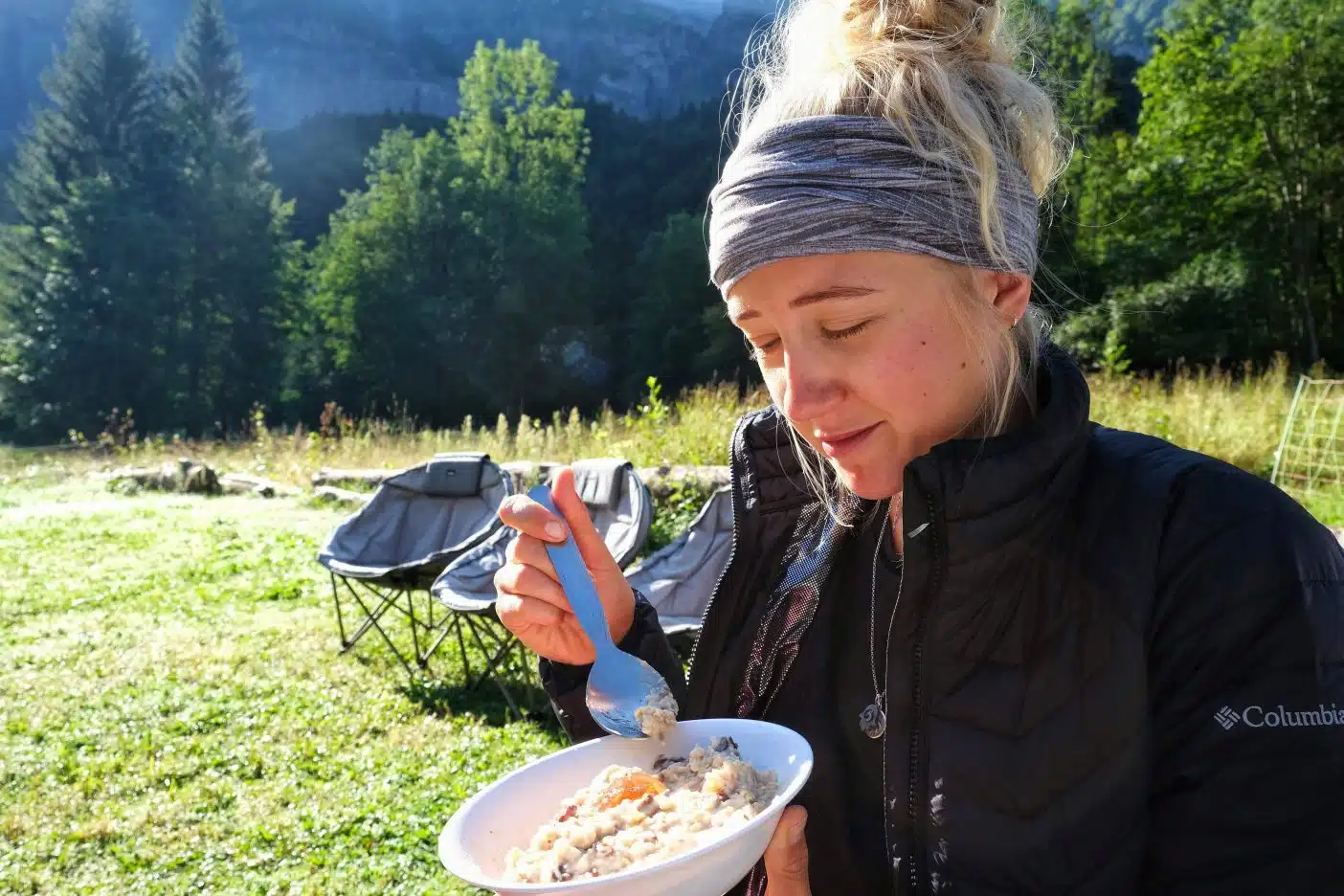
1.3 Convenience
Consider how convenient your grub is to carry, store and eat. It needs to be capable of handling a little bashing too.
Think about easy-to-eat foods that can be gobbled down one-handed whilst on the move or quickly once you’ve made camp. You want to chow down and replenish with as little effort as possible!
1.4 Weather
Depending on the conditions, sitting down for a midday picnic may not be an option. Think about having some lighter vegan hiking foods to eat on-the-go for a quick energy boost (we’ve listed ideas further down).
The climate you’re hiking in will also affect the foods you bring.
In the summer, you don’t want to consume too much salt whilst on the move as it’ll dehydrate you, but then you’ll need to replace those lost electrolytes at the end of the day.
Planning out your vegan camping dinners will mean you can get back lost nutrients with a bigger meal later, potentially in your tent if the conditions are pants.
1.5 Location
If you know you’ll be able to pick up some fresh fruit or veggies along the way, you can add these to your evening camping meals.
This will give added nutrients and you won’t have to carry as much. If, on the other hand, you won’t be passing civilisation for some miles or days then you need to make sure you’re prepared, bringing enough food to keep you going.
In summary: the best vegan backpacking foods will be nutritious, lightweight, easily stored and easily eaten!
If you’re just going to be camping or weight isn’t an issue, you might also want to check out our guide to Vegan Camping Food.
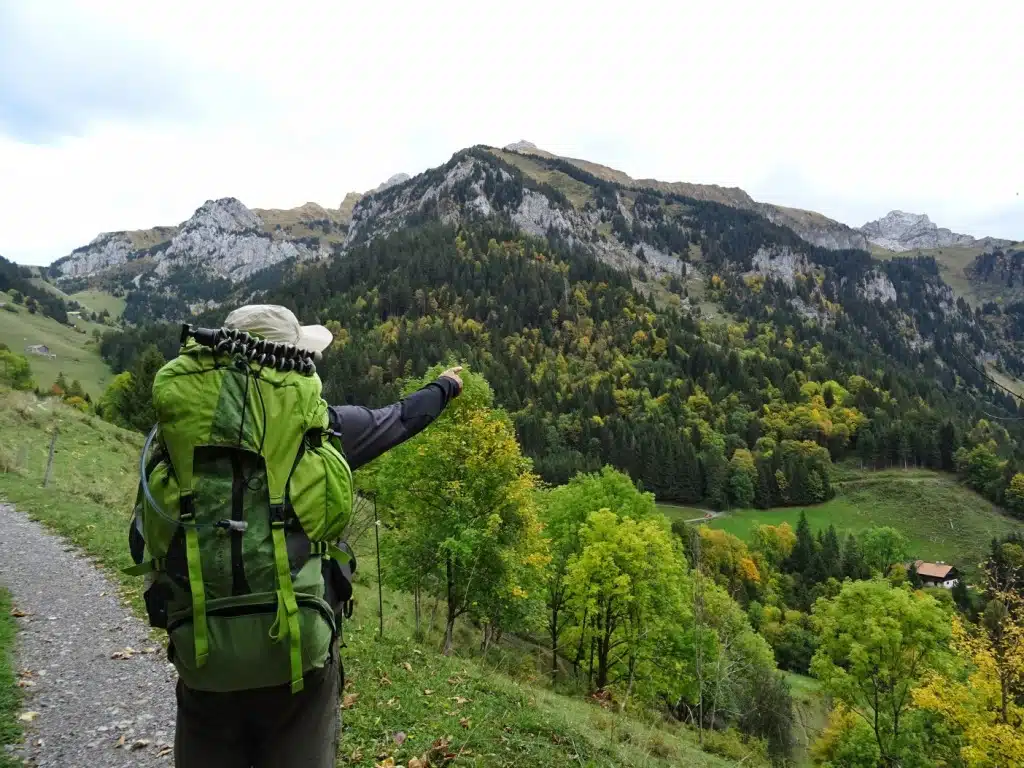
2. What are the best foods to take vegan backpacking? Think NUTRITION!
Your next step is to start thinking about nutrients and getting them from a variety of different foods.
The best backpacking grub will tick many of the boxes below. If they don’t on their own, you should aim to get them across your meals throughout the day.
You’ll notice some food are recommended more than once – they’re particularly good for the trail!
2.1 Calories
This is the time for seriously high-calorie foods. It’s best to stick with healthy options but it would still be better to get bad calories than no calories at all.
These are some healthier high-calorie vegan foods that work a treat backpacking:
- The carbs in the section below
- Any nuts or seeds
- Peanut butter
- Dried fruit
- Trail mix
- Meal replacement shakes
- Oil (you can add extra to meals)
Take a look at our list of the best vegan energy foods for other high-calorie ideas to keep your feeling energized in the outdoors.
2.2 Carbohydrates
The best source of backpacking fuel will come from carbohydrates. Not just any old carbs though, specifically complex carbohydrates as these release energy slowly and will keep you powering on for hours.
Opt for quick-cooking carbs which are well suite to vegan backpacking dishes:
- Oats (can be used sweet or savoury)
- Wholemeal bread/wraps
- Quinoa
- Wholewheat pasta
- Multigrain cereals
- Wholewheat couscous
- Rice noodles
- Banana chips
- Instant mash
- Oatcakes
2.3 Protein
Protein helps your body to recover, which you’re going to need after a day backpacking. It helps build new tissue, antibodies, enzymes, hormones and other compounds.
Despite what the memes say, it’s not difficult to get protein for vegans. The average active man needs 60 grams and active women 50 grams per day, and these plant-based protein sources will help you get your daily dose:
- Beans
- Chickpeas
- Lentils
- Tofu
- Tempeh
- Seitan
- Bulgur Wheat
- Barely
- Oats
- Amaranth
- Rice
Chia seeds Flax seeds - Quinoa
- Farro
- Hemp hearts
- Nuts and nut butters
- Protein powder
- Protein bars
We’ve got a whole post on the best protein sources for vegans if you want extra info.
Oh, and a lot of people overlook the potential of plant-based protein powders. Gram-for-gram they can be one of the most nutrient-packed food options and perfect for the trail. Stir it into your porridge or just have a shake at the end of the day, it’s a great way to recover!

2.4 Fats
Fat gets a bit of a bad press but many are really important for your body. You want to be focusing on unsaturated fats as these give you energy and lower cholesterol. Things such as:
- Nuts
- Seeds
- Avocados
- Peanut oil
- Walnut oil
- Sesame oil
- Plant milk powders
Carrying a bottle of avocado oil on the trail might not be recommended but if you can make some homemade backpacking recipes before you leave, you can add some of the ingredients.
2.5 Vitamins and minerals
Some foods are more nutritious than others. You want to be carrying as little as possible so plan some recipes with foods that are particularly nutrient-dense, lightweight and won’t matter if they get a good bashing in your bag, such as:
- Seaweed
- Carrots
- Broccoli
- Kale
- Peas
- Beetroot
There are also a number of pastes and powders that are packed full of goodness and ideal for camping meals as they’re so convenient to carry.
If you’re making homemade vegan backpacking recipes you can add these in, or sprinkle some on your camp stove cook-up in the wild.
Miso paste - Nutritional yeast
- Spirulina
- Turmeric
- Acai
- Baobab
- Cacao
- Camu Camu
- Maca
- Matcha
- Moringa
- Superfood blends
- Protein powder
- Many prepared dehydrated vegan meals may also contain added nutrients
Not sure where to buy these awesome health-boosters? You can easily find them at
Don’t forget your daily dose of vitamin B12. It doesn’t naturally occur in many plant-based wholefoods so opt for these vegan foods with B12.
2.6 Salts and electrolytes
When you’re working your butt off trudging up a mountain, you’ll be losing more salts and electrolytes than you realise. You gotta replace them and these can help:
- Salted nuts
- Seaweed
- Kale
- Isotonic powders and rehydration tablets (we like
Tailwind !) - Himalayan salt to add to dishes

3. How many calories and nutrients do you need backpacking?
Depending on your physical build and the intensity of your backpacking trip, you should aim for 3,000 to 4,500 calories a day. Listen to your body and keep yourself fuelled.
An active person is also recommended to consume:
- 300 grams of carbs a day
- 50 grams of protein a day
- 60 grams of fat a day
But for an active backpacker, this will likely be more.
Aim to spread the calories across these food types and then you can add additional nutrients with fruits, vegetables and supplements.
Trying to work out the nutritional content of your daily backpacking food on the trail would be a nightmare. This is when meal planning comes in!
4. Backpacking meal planning
If you’re working hard, ideally you want to be taking on calories every few hours. We find the best method for long backpacking days is roughly like this:
- 7.30 am – a hearty warm breakfast at the beginning of the day
- Midday and 4 pm – two smaller cold food breaks spread throughout the day (better than a single, longer break when you can get stiff or feel the need to eat too much)
- 6 pm – a hearty warm camping dinner to replenish nutrients and electrolytes
- Throughout the day – high-energy backpacking snacks for on-the-move
Across these meals, you can plan foods so you know you’re getting the right stuff.
The next steps will guide you through actually bringing all the food with you!
Explore more…
The Best 2-Person Tents Compared
Check Out More Vegan Adventure Recipes
Find All Our Vegan Adventure Content
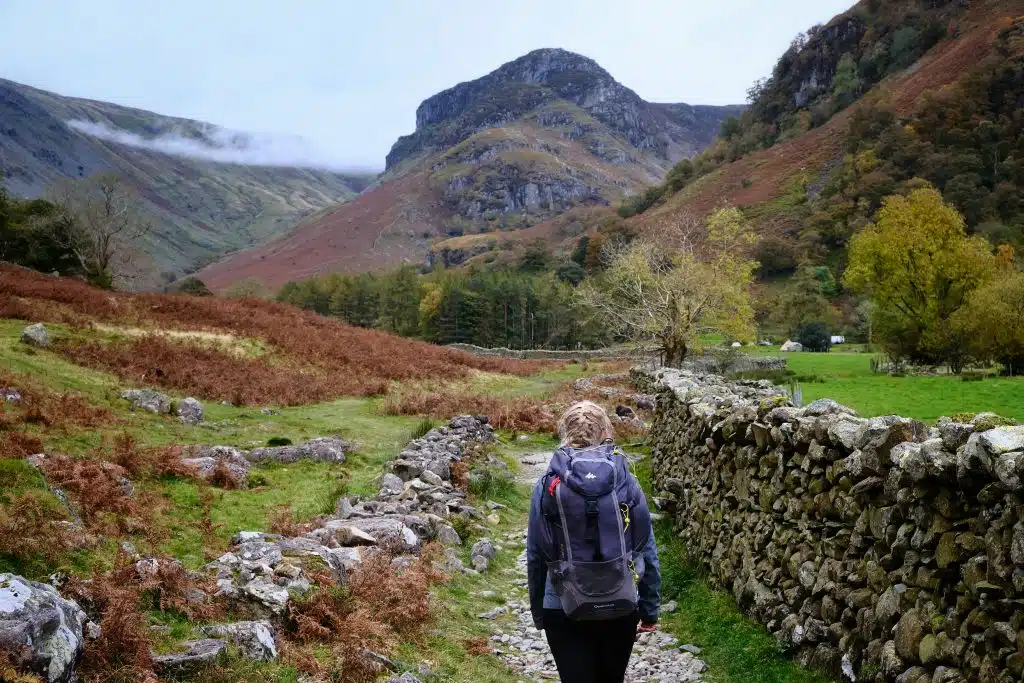
5. Different food options & how to take it
To fit enough food in a backpack, you’ve got to be crafty, and the best method will depend on your trip. First think:
- How long are you backpacking for?
- Will you be able to resupply along the trail?
- Would you prefer to prep more before hiking or spend longer prepping food on the trail?
You’ll likely find a combination of the methods below will work best, then you can pick the right food options for your trip.
A. Bringing whole goods to use on the trail
Bringing things like oats to make porridge or rice and ingredients to make dinner.
For most, it’s inevitable you’ll bring whole goods. They’re cheaper, healthier and easily resupplied along the trail. But, they can be heavier and are more time-consuming to prepare.
B. Bringing ready-to-eat or pre-packaged foods
Anything from packets of biscuits to specific dehydrated backpacking meal sachets or sauce packets.
It’s good for making food quickly and it can be lighter. On the downside, it’s typically more expensive, less healthy and dehydrated meals or specific backpacking foods can be harder to resupply.
C. Preparing meals or foods before the trail
Preparing snacks or energy foods before the trail, like trail mix and energy balls, or dehydrating foods/ingredients to bring.
This is awesome for meal planning and can be cheaper, healthier and lighter if dehydrated. Resupplying along the trail is unlikely and it takes prep time before backpacking.
Need some vegan outdoor gear for your trip? We’ve got you covered!
Picking the Best Vegan Hiking Boots
Finding Vegan-Friendly Sleeping Bags
Vegan Insulated Jacket Buyer’s Guide
6. Good vegan backpacking foods available in shops (and potentially along the trail)
These are ace things to stock up on before your trip and you’ll likely find them in trail-side shops too.
Opt for things with a long shelf-life, that can get thrown around and come in light packaging. Don’t go for canned or glass goods, see if you can find them in sachets instead.
- Oats
- Peanut butter
- Dried fruit or fruit leathers
- Baby food (it’s high in calories, cheap and nutritious)
- Noodles/ramen/supernoodles
- Pasta/rice/cous cous
- Nuts and seeds
- Trail mix
- Sweet treats for energy
- Instant mash
- Sauce sachets
- Bean or pulse sachets
- Sachets of ready meals
- Plant milk powders
- TVP – texture vegetable protein
- Dried soya chunks
- Nutritional yeast
- Herbs, seasoning and condiments (more info below)
PRO TIP: It’s a good idea to take lightweight ziplock bags so you can decant shop-bought food from heavy packaging. You can also do this to ration supplies each for each day.
Oh, and if you’re not sure about the camping aspects of your backpacking trip, our First-Timers’ Camping Guide and this Camping Checklist will be handy resources!
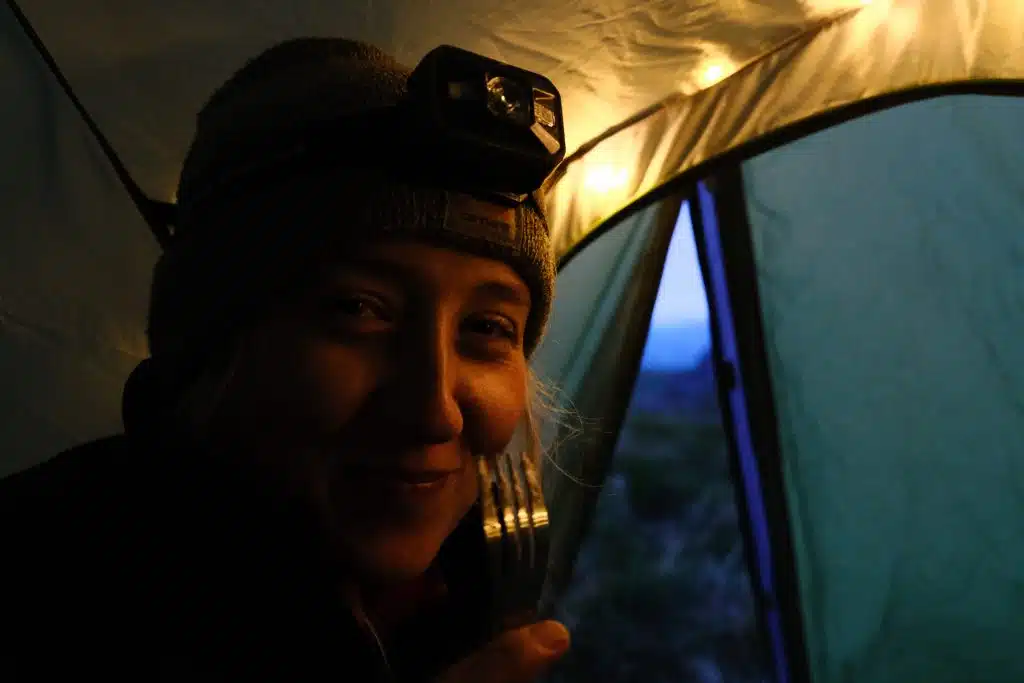
7. Foodie things you’ll need on a vegan backpacking trip
We won’t go into a full backpacking packing list, but there are some crucial things you’ll need to eat your vegan grub!
- A plate or bowl
- A mug for brews!
- Cutlery, chopping knife and potentially something to serve/stir food
- Cooking pots and pans
- A stove, gas and lighter
- Ziplock bags to decant resupplied food
- Tupperware can be useful for storing leftover food
- Can opener
- Herbs (more below)
- A dehydrator to use at home, removing moisture from foods, making it small, light and easily stored (we like our
VonShef dehydrator! )
8. Pimping your backpacking food
Just because you’re in the middle of nowhere and living in a tent doesn’t mean your food has to be anything short of delicious. These are things you can take to liven up your dishes:
- Nutritional yeast
- Dried seaweed
- Tomato puree
- Stock cubes
- Salt and pepper
- Chilli
- Onion and garlic powder
- Chilli flakes
- A selection of your favourite dried herbs and spices
Foodie tip: why not create spice mixes before you go? It’s an easy way to make Mexican, Indian, Italian etc. inspired dishes super quickly. Just mix the needed herbs and keep it in a zip lock bag. You’ll find some of our favourite spice mixes in our Vegan Camping Food Tips.
It’s really not hard to make epic meals when you’re on the trail – check out the next section for recipe inspiration!

Recipe and Meal Inspiration
We’ve listed some of our favourite plant-based backpacking dishes for when you’re out on the trail and also some tasty ideas you can make before. Enjoy!
9. Vegan backpacking breakfast ideas
Tuck into some slow-release carbohydrates to give you energy through the day, plus plenty of protein to repair your muscles and increase the oxygen in your blood.
You want something quick and easy to digest. This is also a good point to hydrate, so make the most of teas, coffees and nearby water sources.
- Dried Fruit – raisins, goji berries, figs, dates, apricots, cranberries etc. all great for added fibre and nutrients.
- Nut butter – for added protein and fats.
- Seeds – ideal to get an extra dose of protein, fats and energy
- Fresh Fruit – tougher choices like apples, oranges, pears etc.
- Jam – cheap and good for quick energy blasts
- Savoury – you can also have it savoury and for other meals
Porridge (oatmeal) – The ultimate box-ticking and customisable backpacking food. Use oats and water as your base with a few teaspoons of sugar, cooked and thickened to your desired consistency, then mix in toppings of your choice:
Banana, jam and peanut butter wrap – A great quick backpacking breakfast. Smear peanut butter, jam, vegan chocolate spread, chestnut spread or any other spread of choice on your wrap, add the banana, sprinkle with seeds and you have your ultimate breakfast wrap.
Simple vegan breakfast pancakes – Nowadays, you can get complete vegan pancake mix, you just need to add water, mix and fry in a pan. These mixes are packed full of protein and carbohydrates, plus you can top them with lots of extra goodies too.
Tofu Scramble – You can buy cartons of tofu which are easily stored in a backpack and are one of the few complete vegan protein sources. It’s not the lightest, so it’s good soon after a resupply.
We love it with nutritional yeast, garlic and onion powder, paprika, chili, salt and pepper, then thrown into a wrap for a banging breakfast burrito!
HEALTH KICK: the morning can be a good time to get extra nutrients from powders or supplements. Superfood powders can easily be added to porridge, pancakes or in drinks.
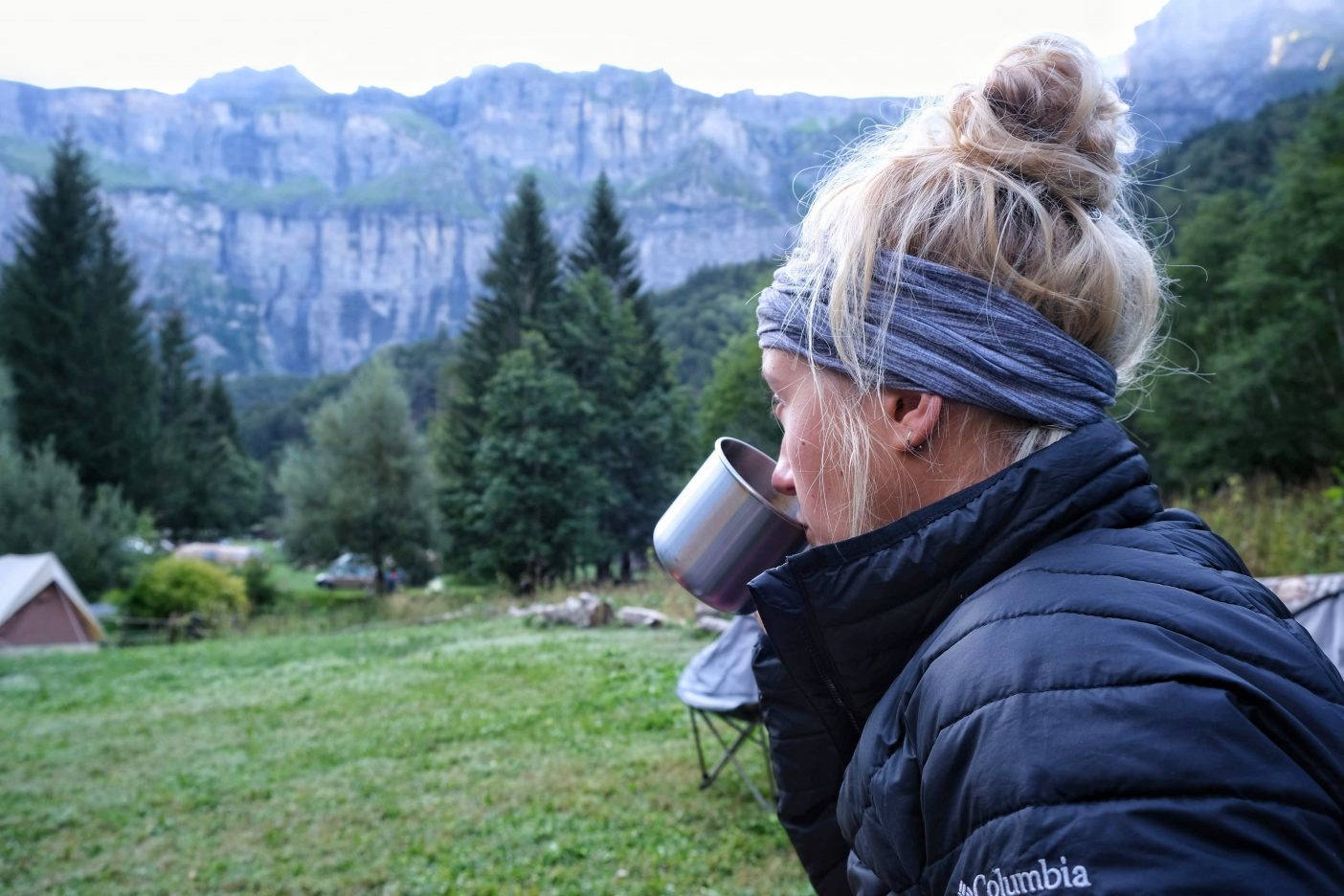
10. Snacks and homemade food to make before you leave
It’s always a good idea to have a steady supply of easy-to-eat snacks, both sweet and savoury, for when your energy levels are lagging.
These are a few go-to recipes we prepare at home before hitting the trail, crammed with energy, protein and darn tasty!
Energy balls – our homemade recipe is easy to whip up and contains a good balance of slow-release energy, sugars and proteins, perfect to gobble down on the move.
Flapjacks – having tried and tested a few ingredient combinations, we’ve perfected this recipe and it’s now a staple for hiking and backpacking trips. Combining banana, oats, almonds and raisins makes them insanely good and the ideal fuel for the outdoors.
Banana bread – a vegan staple and with good reason. Top with nut butter or jam for the ultimate adventure snack.
Raw cacao bars – crammed with slow-release energy and easy to fling into your bag ready for munching on the go.
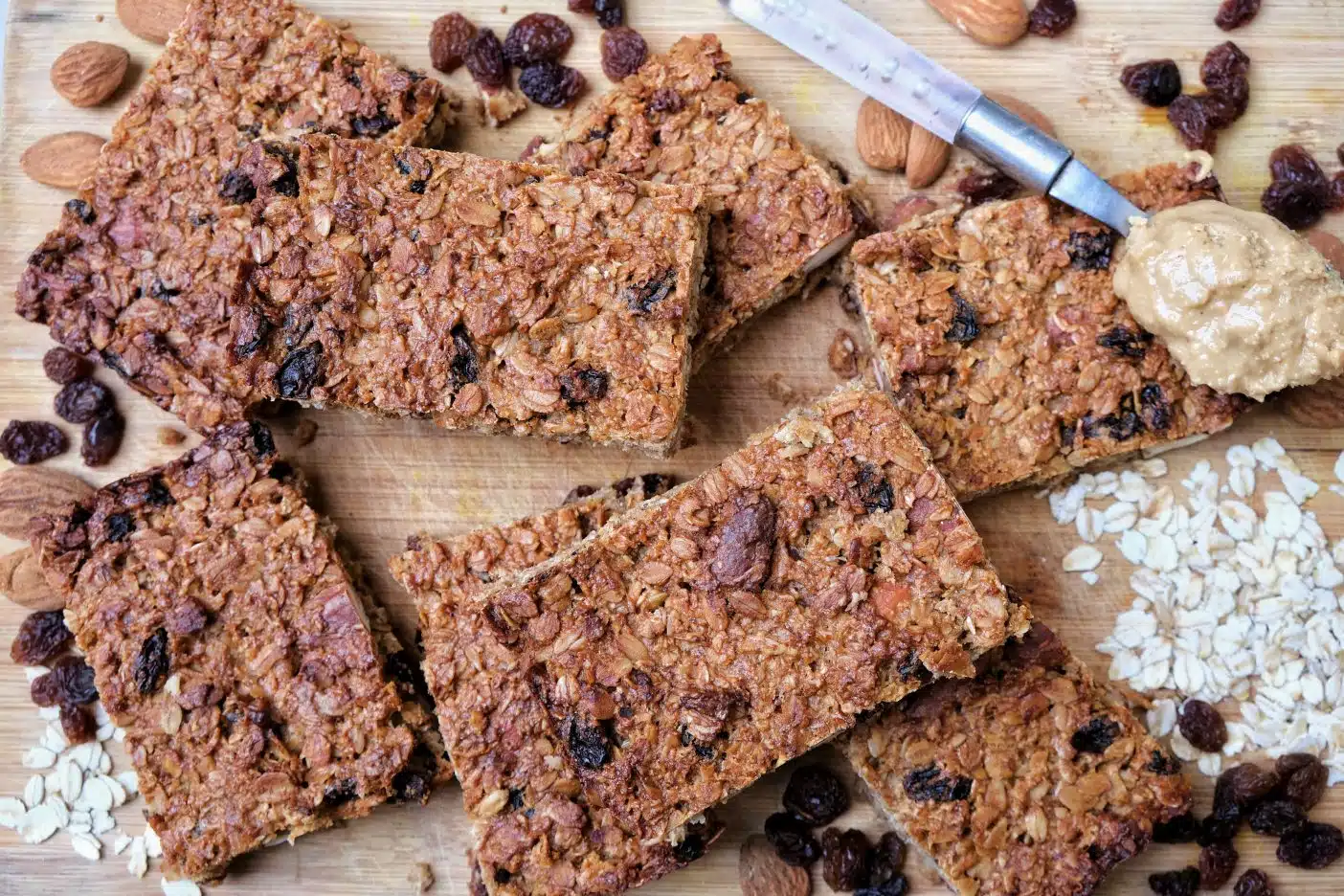
Cookies – at the top of our vegan day hike food list has recently been homemade ginger cookies. They’re ideal for when you need a quick insertion of energy, can take a backpack battering and taste bloody fantastic.
Curry roasted chickpeas – simply toss chickpeas in oil, curry powder, cumin seeds and garlic powder then roast until crispy then presto you have the perfect savoury snack mixing it up from all the sweet stuff. These are also great sprinkled on your evening meal for an extra dose of protein.
Lentil patties – a delicious way to add some protein to your hike and an easy one to make in advance. Either cook the lentils or buy tinned, then saute onion and garlic in oil before adding the lentils, parsley, lemon, salt and pepper to taste (you can also add stock as this will amp up the flavour and salt level). Blend the mixture to form a paste, leaving some chunky bits, before transferring to a baking paper-lined baking tray and baking at 180°C for 20 minutes, turning halfway through.
Trail mix – simple and easy way to get a good dose of energy and vitamins in every handful.
Check out our list of the ultimate vegan hiking snacks for some more inspiration of grub for the trail.

11. Vegan backpacking lunches
Unless you’re going at a casual pace, backpacking lunches are best cold, quick-eaten and easily digested. You’re going to be muddy and sweaty, wanting nom as quickly as possible, without getting more mucky and frustrated.
We find it best to avoid food that’s too salty and focus on rehydrating too.
Tortillas & wraps – these are great as it doesn’t matter if they get bashed about in your bag. Add sweet or savour fillings to satisfy your lunchtime hunger:
- Banana and peanut butter, for optimum muscle recovery and fuel
- Tahini with optional hot sauce (you can also add a sprinkling of seeds for added nutrients and protein)
- If we’re feeling lazy, we’ll throw in some biscuits or sweet treats with peanut butter (pretty rich but gives you calories, carbs, protein, fats and sugars)
You can always use bread, rolls or bagels as the vehicle for your filling but these don’t travel quite as well as wraps.
Bigger quantities of backpacking snacks – vegan or not, sometimes it’s easiest just to tuck into more of your hiking snacks or things like:
- Crackers and jam
- Dehydrated hummus
- Vegan granola or breakfast bars
- Dried fruits and trail
- Vegan jerky
- Nut butters
- Energy/protein bars
OUR SECRET FAVOURITE – We love preparing a big load of breakfast porridge (oatmeal) and keeping leftovers in Tupperware. Come lunch it’s like overnight oats, is easy to eat and jam-packed with nutrients!
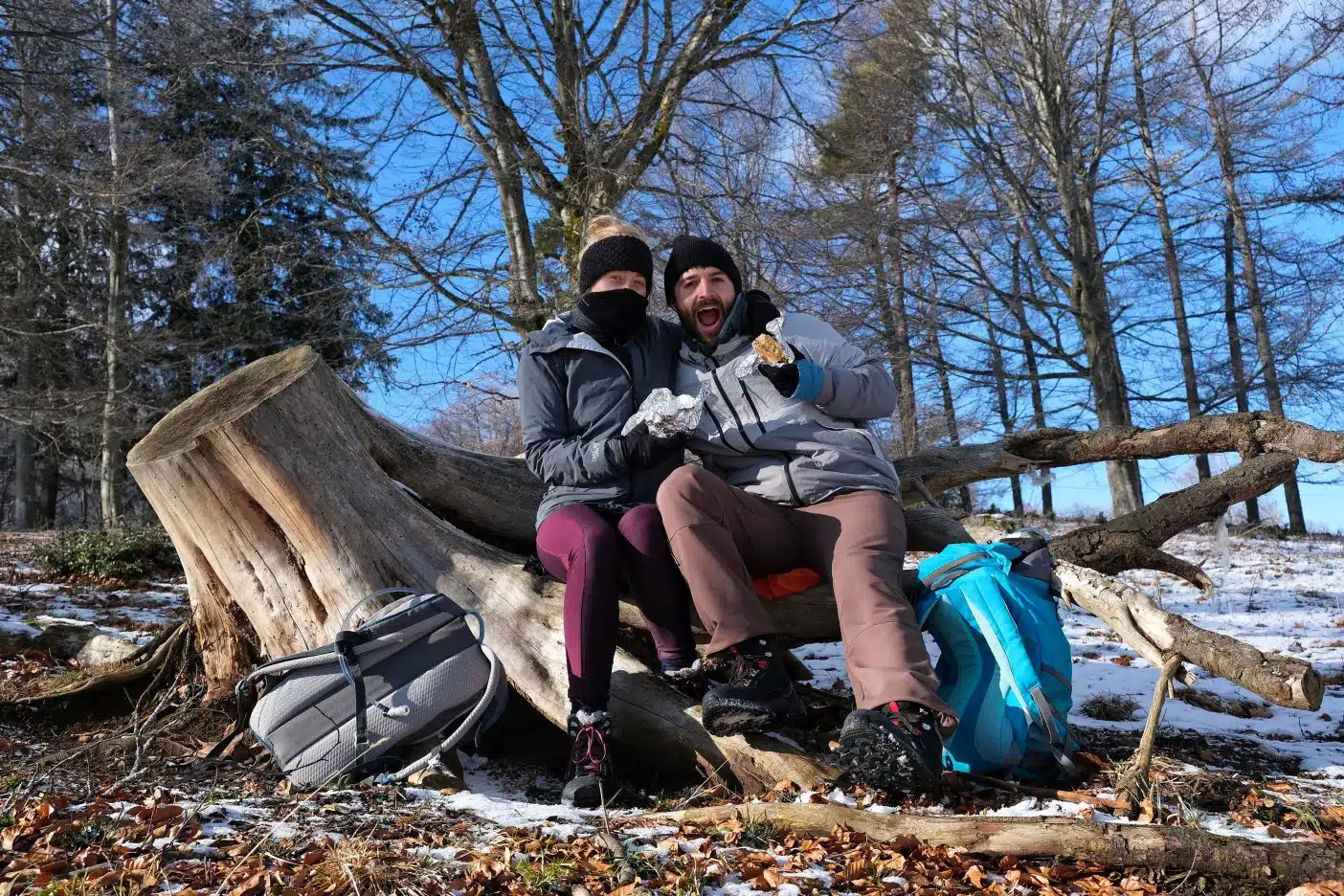
12. Vegan backpacking dinners
Out of all the meals of the day, dinner can be the hardest to tick the backpacking boxes. But, this is the meal where you want to replenish, replace salts and recover from a wild day – so it’s important.
There are a number of shop-brought dehydrated meal options available which are ideal for your hiking expedition and are lightweight, fuss-free and nutritional.
If you want to make your own vegan backpacking meals then this guide on how to dehydrate your food is great for beginners too.
Buying dehydrated meals or dehydrating food yourselves might not be an option, so these can help.
Easy steps for building a backpacking meal:
- Think of the carbohydrate you can use e.g. rice, noodles, cous cous, bread etc.
- Think of your protein e.g. TVP, soya chunks, sachets or beans or pulses
- Craft your sauce – can be from sauce sachets, your herbs and seasonings, or you can easily make a tomato base by combining tomato puree and water or chopped tomatoes.
These are some other backpacking dinner ideas we love
Instant noodles a.k.a Ramen – they’re a backpacker staple and with good reason: super lightweight, convenient and tasty. The only downside is they’re often full of salt and chemicals which is fine for short trips but doesn’t make them a great option long-term.
Miso soup – a healthier alternative to the above, made by mixing a dollop of miso paste with seaweed, noodles plus veggies if you can pack or dehydrate them. The miso and seaweed are crammed with nutrients making this a super nutritious vegan camping recipe.
Seitan – You can make a seitan loaf at home as it travels well, then mix it into sauces as a protein and nutrient source. These are good flavour combos to make at home:
- Miso, seaweed and mushroom
- Nutritional yeast, turmeric, garlic, onion
- Ground flax seeds or chia seeds
- Veggies of your choice
- Nuts and nut oils
TIME TO RECOVER: It’s not always possible to get a perfectly balanced meal but your body will appreciate it. Times like these can be good for an evening vegan protein shake or meal replacement shake.
Your questions answered – FAQ
Where can you buy vegan backpacking food?
Nowadays, you can buy dehydrated or freeze-fried vegan backpacking foods from outdoor stores, like REI in America and Cotswolds in the UK.
Are there any no-cook vegan foods for backpacking?
How can you plan backpacking meals?
With a rough meal plan, you can see how much supplies you can comfortably bring and work out when/if you’ll need to resupply.
How can you store backpacking food?
Avoid glass or heavy container options.
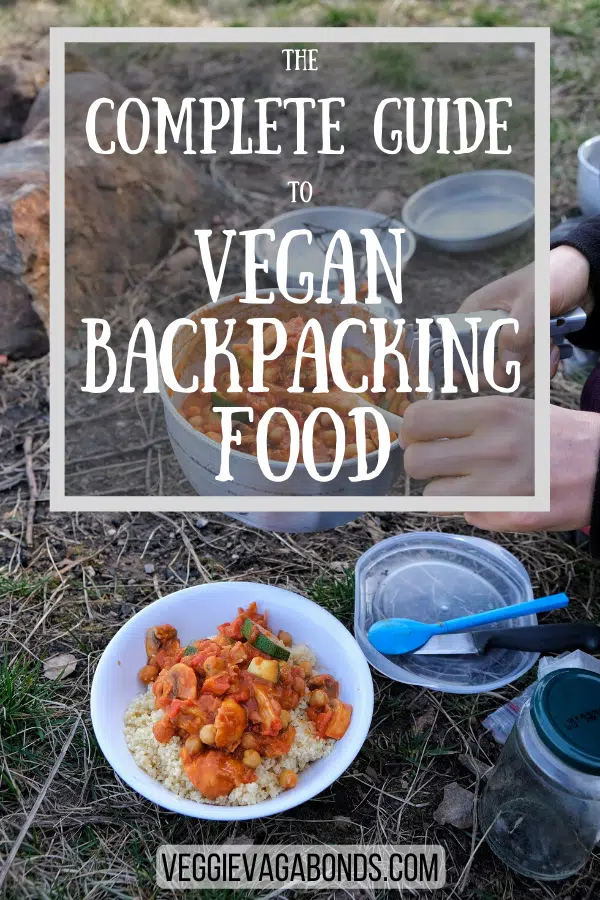
The Complete Guide to Vegan Backpacking Food
The natural world is best appreciated by getting out there and exploring, we believe this is how people feel most compelled to protect it. This guide is aimed to help you do just that, with practical, healthy, affordable and delicious vegan-friendly backpacking foods to fuel your trip!




